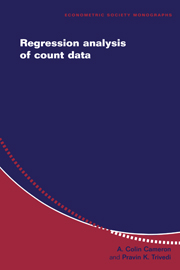Book contents
- Frontmatter
- Contents
- List of Figures
- List of Tables
- Preface
- 1 Introduction
- 2 Model Specification and Estimation
- 3 Basic Count Regression
- 4 Generalized Count Regression
- 5 Model Evaluation and Testing
- 6 Empirical Illustrations
- 7 Time Series Data
- 8 Multivariate Data
- 9 Longitudinal Data
- 10 Measurement Errors
- 11 Nonrandom Samples and Simultaneity
- 12 Flexible Methods for Counts
- Appendices
- References
- Author Index
- Subject Index
- Titles in the series
6 - Empirical Illustrations
Published online by Cambridge University Press: 05 January 2013
- Frontmatter
- Contents
- List of Figures
- List of Tables
- Preface
- 1 Introduction
- 2 Model Specification and Estimation
- 3 Basic Count Regression
- 4 Generalized Count Regression
- 5 Model Evaluation and Testing
- 6 Empirical Illustrations
- 7 Time Series Data
- 8 Multivariate Data
- 9 Longitudinal Data
- 10 Measurement Errors
- 11 Nonrandom Samples and Simultaneity
- 12 Flexible Methods for Counts
- Appendices
- References
- Author Index
- Subject Index
- Titles in the series
Summary
Introduction
In this chapter we provide a detailed discussion of empirical models based on two cross-sectional data sets. The first of these analyzes the demand for medical care by the elderly in the United States. This data set shares many features of health utilization studies based on cross-section data. The second is an analysis of recreational trips.
Section 6.2 extends the introduction by surveying two general modeling issues. The first is the decision to model only the conditional mean versus the full distribution of counts. The second issue concerns behavioral interpretation of count models, an issue of importance to econometricians who emphasize the distinction between reduced form and structural models. Sections 6.3 and 6.4 deal in turn with each of the two empirical applications. Each has several subsections that deal with details. The health care example in section 6.3 is intended to illustrate in detail the methodology for fitting a finite mixture model. There are relatively few econometric examples that discuss at length the implementation of the finite mixture model and the interpretation of the results. The example is intended to fill this gap. Section 6.5 pursues a methodological question concerning the distribution of the LR test under nonstandard conditions, previously raised in section 4.8.5. The final two sections provide concluding remarks and bibliographic notes. The emphasis of this chapter is on practical aspects of modeling. Each application involves several competing models which are compared and evaluated using model diagnostics and goodness-of-fit measures.
- Type
- Chapter
- Information
- Regression Analysis of Count Data , pp. 189 - 220Publisher: Cambridge University PressPrint publication year: 1998



